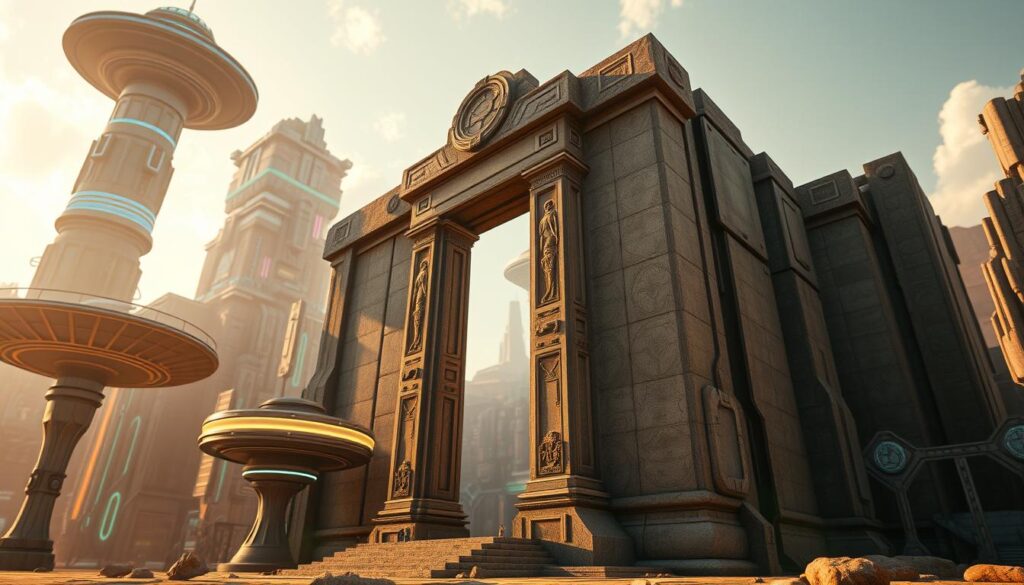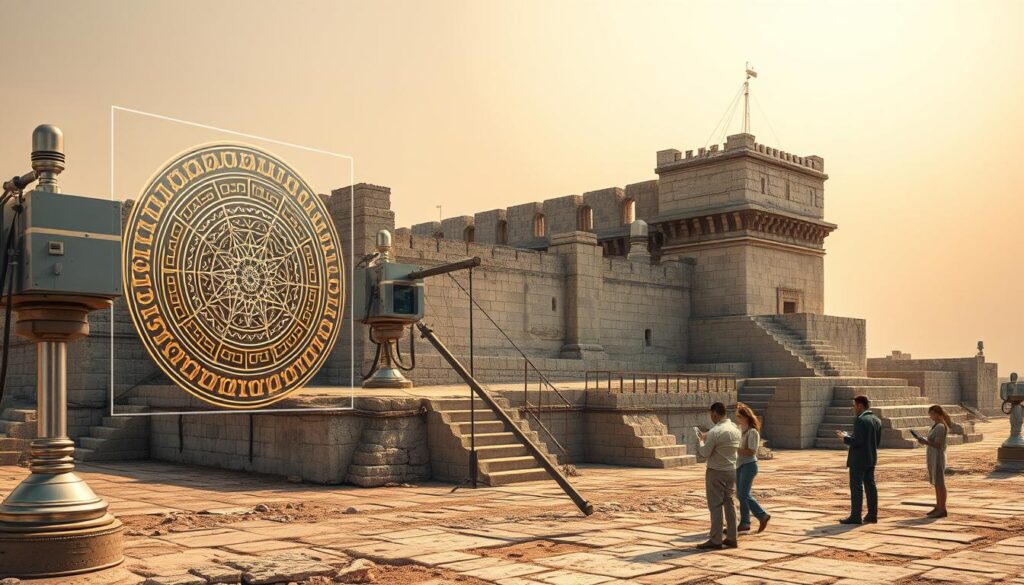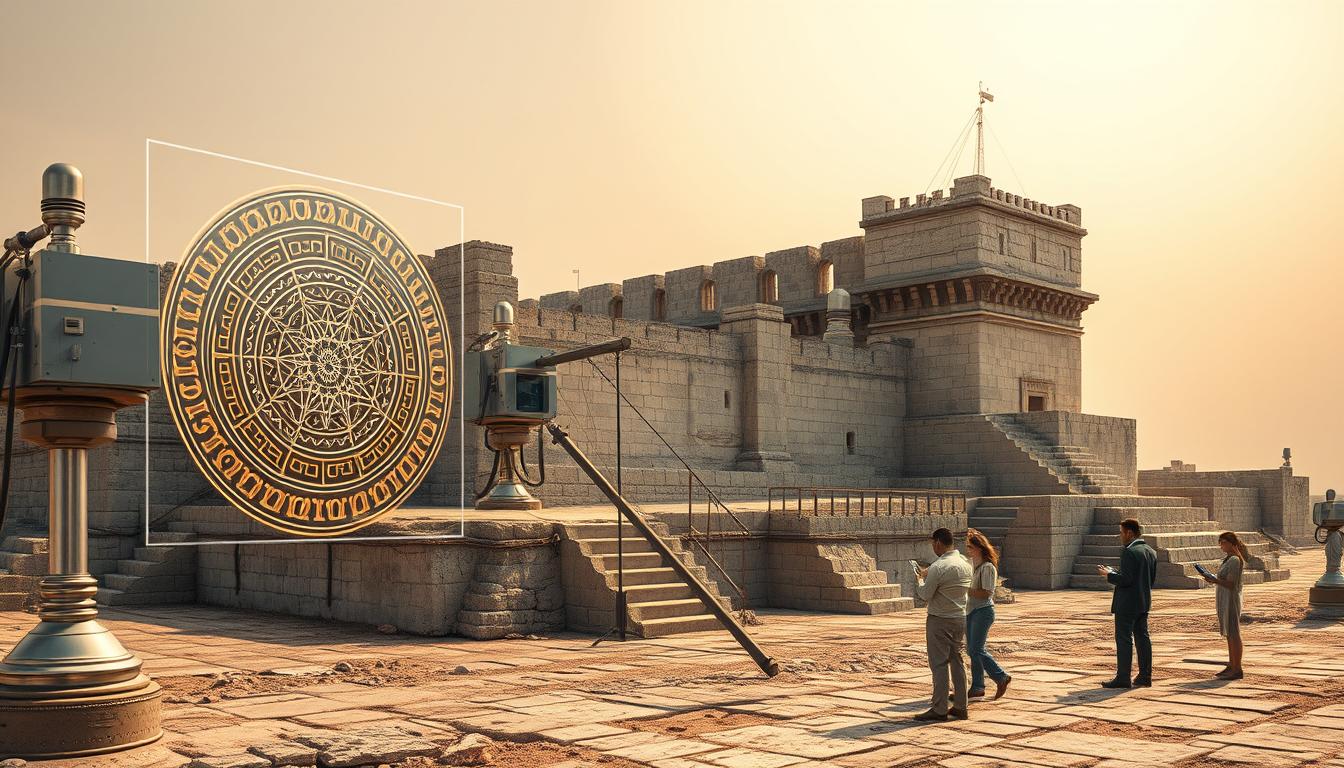Keeping our cultural heritage alive is key. Using modern tech in ancient sites makes them more interesting and accessible. This mix of old and new helps us cherish our history for years to come.

Innovative ways to save our history are exciting. Ancient sites with modern tech offer new learning chances. It’s a great step in keeping history alive and engaging.
Introduction to Ancient Structures with Modern Technology
This part talks about blending ancient sites with modern tech. It shows how important it is to save our history. From digital maps to smart systems, it’s changing how we see and interact with old places.
Key Takeaways
- Ancient structure with modern technology enhances our understanding and appreciation of historical sites
- Historical preservation is crucial in maintaining our cultural heritage
- Integrating modern technology in ancient structures provides a more engaging experience for modern audiences
- Ancient structure with modern technology offers new opportunities for education and research
- Historical preservation is essential for preserving our cultural heritage for future generations
The Evolution of Ancient Architecture in the Modern World
Exploring ancient structures and modern technology shows us that architecture is more than just the past. It’s about looking forward too. New building methods and tech have made buildings more green, efficient, and strong.
Using modern tech with ancient buildings is key to keeping them safe. It lets us make these old sites useful and protected for the future. We can do this with new materials, energy-saving systems, and advanced care methods.
- Understanding traditional building techniques and their significance in modern construction
- The need for technological integration to enhance the sustainability and efficiency of ancient structures
- Promoting innovation in heritage preservation to safeguard the cultural and historical value of these sites
By mixing old and new, we can make ancient buildings important again. This mix of old and new shows how tech can help keep our cultural heritage alive. It also shows the power of modern tech to improve and protect these amazing sites.
How Modern Technology is Revolutionizing Historical Sites
Modern tech is changing historical sites for the better. Renewable energy and green materials are used to lessen environmental harm. This way, sites stay safe for the future and keep their original look.
Here are some ways tech is being used:
- Renewable energy systems, such as solar and wind power
- Green building materials, such as recycled materials and low-carbon concrete
- Energy-efficient lighting and heating systems
These techs help the environment and make sites more self-sufficient. By using sustainable technologies and historical preservation practices, sites can cut down on carbon emissions. This supports a greener future.
Ancient Structures with Modern Technology: Success Stories
Using digital tools with ancient structures is a big trend in keeping them safe. It helps protect and improve historical sites for the future. This mix of old and new has worked well in many places, showing how technology can make ancient sites come alive again.
For example, digital mapping has helped the Pyramids of Giza. The Roman Colosseum now has a smart monitoring system. And Petra has advanced water management. These examples show how modern tech can help preserve ancient wonders.
- Enhanced preservation and protection of historical sites
- Improved visitor experience through interactive exhibits and guided tours
- Increased accessibility and engagement with ancient structures
By using digital tools and modern tech, ancient sites can be made new again. They can be shared with more people, keeping their cultural and historical value alive for the future.
Digital Tools Reshaping Archaeological Discovery
Archaeological discovery is changing fast with digital tools. Smart materials help keep historical sites safe. Digital archaeology brings new ways to dig, analyze, and share discoveries.
Digital tools like 3D scanning and virtual reality are getting more use. They let researchers make detailed models of old sites. This makes learning about history more fun and real.
Some top digital tools in archaeology are:
- 3D scanning and modeling
- Virtual reality and augmented reality
- Geographic Information Systems (GIS)
- Remote sensing and aerial photography
These tools help find and share history with more people. Digital archaeology lets researchers show their work to everyone. This helps us all understand and value our past.

The field of using digital tools in archaeology is growing fast. New tech and methods keep coming. As we explore more, we’ll find even better ways to keep and share our history.
Smart Materials in Historical Restoration
Historical restoration has changed a lot with smart materials. These materials help keep old buildings safe for the future. They are used in many ways, like self-healing concrete and special stone treatments.
Some key uses of smart materials include:
- Self-healing concrete, which fixes cracks and damages on its own
- Nano-technology in stone preservation, which makes stones stronger and protects them
- Climate-responsive materials, which adjust to environmental changes to protect buildings
Virtual reality is also being used with smart materials. It lets people explore old buildings in a new way. It also helps in restoring buildings by showing them accurately.
Smart materials and virtual reality are changing historical restoration. They help keep old buildings safe for a long time. With these technologies, preserving history is getting easier and more exciting.
| Smart Material | Application | Benefits |
|---|---|---|
| Self-healing concrete | Restoration of historical structures | Automatically repairs cracks and damages |
| Nano-technology in stone preservation | Preservation of historical stones | Strengthens and protects stones from deterioration |
| Climate-responsive materials | Protection of historical structures from environmental damage | Adapts to changing environmental conditions to minimize damage |
Sustainable Technologies in Ancient Buildings
Historical sites are now using sustainable technologies to cut down on their environmental impact. This move helps keep these sites intact for the future while showing modern buildings how it’s done. Solar panels and green roofs are just a few examples of these green upgrades.
Some historical sites have already started using sustainable technologies with great success. For example, solar panels can help power these sites, making them less dependent on fossil fuels.
There are many advantages to adding sustainable technologies to historical sites. These include:
- Less energy use
- Lower costs to run
- Better care for the buildings
These points show why it’s key to use green tech in historical sites. It helps them last longer and stay eco-friendly.
Virtual Reality and Ancient Architecture
Imagine walking through Rome’s ancient streets or exploring Machu Picchu’s ruins from home. Thanks to virtual reality, this is now possible. Virtual reality is changing how we see and interact with cultural heritage sites.
With virtual reality, we can dive into historical experiences. It lets us explore and learn about ancient buildings in a fun, hands-on way. This tech makes cultural sites more fun and accessible for everyone.
- It makes learning fun: Virtual reality can turn lessons into interactive adventures that teach about old cultures and buildings.
- It’s easy to access: You can visit cultural sites from anywhere, without needing to travel.
- It helps preserve sites: Virtual reality can create detailed models of sites, aiding in preservation and restoration.
As virtual reality gets better, we’ll see more cool uses in ancient architecture and preserving culture.
Challenges in Merging Old and New
Integrating modern tech into ancient sites is tough. One big worry is technological integration without harming the site’s history. It needs careful planning to keep the site’s original feel.
Keeping the site’s authenticity is key to historical preservation. This means using tech that fits with the site’s old materials and ways of building. But, this can take a lot of time and skill.
Some big challenges include:
- Ensuring new materials and tech work with the site
- Keeping the look of the site unchanged
- Finding a balance between preserving and making the site safe and easy to visit

Even with these hurdles, many think the benefits of technological integration in historical preservation are worth it. New tech can help our cultural treasures last longer. It also makes these sites more fun and accessible for everyone.
Future-proofing Historical Structures
As we look ahead, it’s vital to think about how our actions will affect historical sites. Future-proofing these places is key to keeping them safe and standing strong. We need to use smart strategies and tech to protect them from harm. Understanding the site’s history, materials, and cultural value is also crucial.
To make sure historical sites last, we can try a few things. These include:
- Predictive maintenance systems, which use data and sensors to watch over the site and spot problems early
- Climate change adaptation strategies, which help us deal with how climate change affects the site
- Long-term preservation technologies, like new materials and ways to keep things safe
By using these methods, we can help historical sites stay safe for future generations.
Technology also plays a big part in protecting these sites. New tools like digital maps, smart monitoring, and virtual reality help us learn more and keep sites safe. These tech tools make it easier to care for our cultural treasures, ensuring they’re around for a long time.
| Strategy | Description |
|---|---|
| Predictive Maintenance | Uses data and sensors to monitor site condition and predict potential issues |
| Climate Change Adaptation | Assesses and addresses impacts of climate change on the site |
| Long-term Preservation | Involves advanced materials and conservation techniques |
The Global Impact of Modernized Ancient Structures
Modern technology in ancient structures has a big global impact. It makes historical sites more culturally, economically, and socially important. This is seen in the rise of modernized ancient structures as tourist spots. It helps people understand and value different cultures more.
Places like the Pyramids of Giza, the Roman Colosseum, and Petra are great examples. They use modern tech to keep their history alive, make them easier to visit, and improve the experience for everyone. This makes them even more significant on a global impact level.
The good things about modernized ancient structures include:
- They help preserve and conserve history better.
- Visitors can enjoy them more because they’re easier to get to.
- They bring in more money through tourism.
- They help people learn about and appreciate different cultures.
In short, the global impact of modernized ancient structures shows how innovation and care for history can change things. As we keep exploring new ways, we’ll see more amazing things in making ancient sites modern. This will have a bigger global impact in the future.
Conclusion: Bridging Past and Future Through Technology
The mix of modern tech with ancient structures is truly amazing. It’s changing how we see and save our cultural treasures. With digital tools and new materials, we can make these landmarks more alive and engaging for everyone.
For example, the Pyramids of Giza got a digital makeover. The Roman Colosseum now has a smart monitoring system. This shows how old and new can come together to preserve history in exciting ways.
The future looks bright for this tech mix. Modernized ancient structures can inspire us all. They show how we can mix the past with today’s tech for a better future. Through historical preservation with new ideas, our heritage will stay alive and interesting for years to come.
FAQ
What is the purpose of integrating modern technology into ancient structures?
Modern technology helps keep ancient sites safe and open to everyone. It makes these places more interesting for today’s visitors. This way, our cultural treasures can last for a long time.
How can traditional building techniques be combined with modern technologies?
We can mix old building ways with new tech. This keeps the original look and feel of ancient buildings. It also brings in new ideas for upkeep and access.
What are some examples of successful implementations of modern technology in historical sites?
For example, digital maps help protect the Pyramids of Giza. The Roman Colosseum has a smart system for monitoring. Petra uses advanced water management.
How are digital tools reshaping archaeological discovery?
Tools like 3D scanning and virtual reality change how we find and share history. They make it easier for everyone to explore and enjoy ancient sites.
What are some of the challenges in merging old and new technologies in historical preservation?
Keeping the site’s original feel is a big challenge. Mixing old and new tech can be tricky. It needs careful planning and execution.
How can historical structures be future-proofed through the use of modern technologies?
We can use predictive maintenance and adapt to climate change. Adopting new preservation tech helps these sites last longer and stay strong.
What is the global impact of modernizing ancient structures?
Modernizing ancient sites boosts their cultural and economic value. It helps people understand each other better. These sites become symbols of innovation and preservation.
